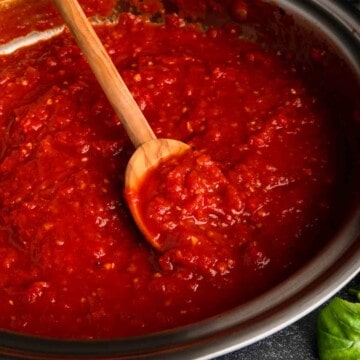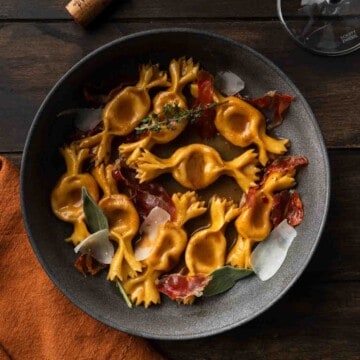These handmade ravioli use our semolina and egg pasta dough filled with a creamy ricotta and spinach filling. It's a classic Italian pasta that pairs beautifully with various sauces.

Pasta is one of my life's greatest pleasures - which may sound extreme, but it's true. I enjoy making pasta just as much as I enjoy eating it, and I hope you do, too. If you are new to pasta making, I recommend you take the time to scroll through this post and check out the step by step photos and advice. You can find further information in my pasta dough recipe or my 5 Ways To Make Ravioli tutorial. Feel free to leave a comment with any questions you may have. Happy pasta making!
For a cheesy stuffed pasta without the spinach, check out our Four Cheese Ravioli recipe.
Jump to:
- Ingredients
- Special Equipment (& No Special Equipment Hacks)
- How To Make Pasta for Ravioli
- Spinach and Ricotta Filling
- Shaping The Ravioli
- How To Cook Spinach Ricotta Ravioli
- Saving & Storing
- Tips for Making Filled Pastas
- Sauces & Serving Suggestions
- Frequently Asked Questions
- You May Also Like...
- Recipe
- Comments
Ingredients

Pasta Dough
- Semolina flour
- All purpose flour - or strong/bread flour
- Eggs (5 yolks and 1 whole egg)
- Water
Spinach Filling
- Whole milk ricotta - I recommend purchasing a high quality ricotta or making your own with our homemade ricotta recipe.
- Parmesan cheese - Grana Padana or Pecorino work, too.
- Spinach - Fresh or frozen
- Seasonings - lemon zest, freshly grated nutmeg, salt and pepper
A Note About Homemade Pasta Dough
Generally speaking, there are two main categories of fresh pasta. The first is made simply from semolina flour and water. It creates a stiff dough that can be extracted and cut through brass dies (like most commercial boxed pasta).
The second style is made with flour (often a finely milled 00 flour) and eggs. The eggs create a richer dough and softer texture that is generally used for stuffed pastas and lasagnas.
The recipe I share here is unique in that it uses both semolina flour AND eggs. I have found that this dough is easy to work with and has the best of both worlds. I use it for every homemade pasta recipe on this site (so far, anyway). The eggs make it silky smooth and rich - perfect for tender, stuffed pastas. Meanwhile, the semolina gives this dough structure and chew allowing it to be used for rigid shapes like handmade rigatoni, paccheri and farfalle.

Special Equipment (& No Special Equipment Hacks)
Ravioli can be made using different methods, and different types of equipment. In a pinch, you can make homemade ravioli with nothing more that a rolling pin, a spoon and a knife. That being said, there are a lot of simple hand tools that can make this job easier.
My number one recommendation for pasta making is to invest in a pasta machine. Mine is a simple hand crank machine that was fairly inexpensive and had lasted me over ten years, and counting!
- Pasta Machine - I use a Marcato Atlas 150. To sheet pasta by hand (with a rolling pin), check out my original pasta dough post - I have a whole section on it.
- Bench Scraper - Helps with pulling the dough together, distributing the egg, and collecting any floury bits from your work surface.
- Scoop or piping bag - To portion the filling. A spoon works, too.
- Pastry Brush - I like using a damp pastry brush to help add moisture to seal the dough. You can just use your fingertip, if needed.
- Fluted Pasta Wheel - I love my pasta wheel but it's certainly not essential. You can use a knife, ravioli stamp, biscuit cutter... Take a peek at my homemade ravioli tutorial for demonstrations on making ravioli using various kitchen equipment.
How To Make Pasta for Ravioli
If you are new to pasta making, I encourage you to visit the homemade pasta dough post, to get a better idea of how to make and handle the dough.
- On a clean work surface, combine all-purpose (or bread) flour with semolina flour. Use your hands, or the bottom of a bowl, to create a well in the center of flour.
- Add the egg yolks, whole egg and a small splash of water into the flour well. Use a fork to whisk the eggs in the center of the well, whisking in a bit of flour at a time.


- When a shaggy dough begins to for, switch to using a bench scraper. Drag the remaining flour over the mixture and use a chopping motion to distribute the eggs amongst the flour. If too dry, drizzle additional water over the dough, to absorb any dry flour.
- Use your hands to pull the dough together.Knead briefly or until the dough is smooth and cohesive. (It is a firm dough). Shape into a ball and cover with a damp towel (or plastic wrap) for at least 30 minutes.


Spinach and Ricotta Filling
Like any filled pasta dish, the key here is to make sure the filling is relatively dry. Drain the ricotta, as needed, and be sure to squeeze all of the water from the wilted spinach. In a pinch, a wet filling can be remedied by adding a few breadcrumbs and allowing them to absorb some of the excess moisture.
- If using fresh spinach, trim the ends and wash it well. Add the freshly washed spinach (without drying) to a large pan. Cook over medium high heat until the spinach has wilted. It will shrink considerably.
- Allow the spinach to cool and then squeeze all of the remaining moisture from it. I like to place it in a fine mesh strainer, folding and squeezing the cooked spinach until dry. (It will compress into a tiny ball. Once dried, finely chop the spinach.


- Combine all filling ingredients together (ricotta, spinach, lemon zest, nutmeg, salt and pepper). Fold together until combined. Set aside (or refrigerate) until ready to shape the ravioli.


You can use this spinach ricotta farce (pasta filling) for various shapes - it's great in manicotti, stuffed shells, tortellini or even caramelle - a cute candy pasta shape.
Shaping The Ravioli
There are several ways to prepare ravioli and you can use whichever method suits you best. As pictured for this post, I use a hand-cut ravioli method. This method requires a small scoop (or pastry bag) and a pasta wheel (or sharp knife).
You can also make this ravioli with a ravioli stamp, ravioli tray maker or using the fold and seal method. Check out my tutorial for shaping ravioli to determine which method suits you (and your kitchen) best.
- Divide the pasta dough into 6 equal portions. Working with one portion at a time, use a pasta machine to sheet the dough until about 1 millimeter thick. (I use setting 6 on an Atlas Marcato 150 pasta machine, about the thickness of a credit card.) Dust the dough with additional flour, as needed, to prevent sticking.
- Use a small scoop to portion mounds of spinach and ricotta filling onto your sheeted pasta dough. Use a barely wet pastry brush to moisten the dough surrounding the filling. (If the dough is at all tacky or a touch over-hydrated, you may be able to skip adding additional moisture.) Add a second sheet of pasta (or fold the dough over itself) to cover the filling.


- Use floured fingertips to gently seal around each mound of filling, squeezing out any air bubbles.


Pro Tip: Start in the Center - When using this method to make hand cut ravioli, I like to start sealing my dough in the center of the pasta sheet, while pushing air outwards - left and right. Start sealing the dough around the fold of the middle mound of filling. Continue sealing the dough, one ravioli at a time, continually pushing air bubbles away from the center and outwards to the unsealed edges.
- Next, use a pastry wheel (cookie cutter or sharp knife) to cut individual ravioli from the sealed dough.
- Transfer ravioli to a semolina lined baking sheet and allow to dry while repeating the process with the remaining dough and filling.

Pro Tip: Save Those Scraps! - The beauty of pasta dough is that it can be repelled several times to continue making more pasta. Brush off any excess flour and bind scraps into a ball. Keep the ball of dough scraps covered (with a damp towel or plastic wrap) to prevent it from drying out. Allow the scraps to rest for 10 or more minutes, before re-rollling to make more pasta.
How To Cook Spinach Ricotta Ravioli
- Bring a large pot of water to a rolling boil. Salt generously.
- Drop ravioli into the water one at a time.
- Boil for 6 - 8 minutes or until pasta is done to your liking. (Usually about 2 -3 minutes after the ravioli begins to float).
- Use a slotted spoon or spider utensil to gently remove ravioli from the water.
- Sauce and serve immediately! Buon appetito!

Pro Tip: Finish Cooking in the Sauce - Whenever I can, I like to finish my pasta directly in the sauce with a splash of pasta water. To do this, heat the sauce in a deep skillet. When the pasta (in this case, spinach ravioli) is almost done, use a spider utensil to transfer the pasta directly into the sauce.
Add a splash of pasta water (about ½ Cup, or so) and bring the sauce to a simmer. Stir vigorously for 2 - 3 minutes until the pasta is finished coking and the pasta water has reduced down, thickening the sauce around the pasta. This method helps the pasta to adhere with the sauce and makes each bite perfectly sauced and seasoned.
Saving & Storing
Spinach ravioli can be boiled and eaten immediately or refrigerated or frozen to enjoy later.
- Refrigerator: I recommend freezing over refrigerating but if needed, fresh ravioli can be stored in the refrigerator for 2 - 3 days. Be mindful of keeping it very well covered, so the edges don't dry out or oxidize. After about an hour, flip each ravioli to encourage the underside to dry, as well. Keep the ravioli in a single layer on a semolina dusted baking sheet. Keep well covered with plastic wrap.
- Freezer: Fresh ravioli can be frozen. For the best quality, I recommend freezing for a maximum of 2 - 3 weeks. Freeze ravioli in a single layer on a baking sheet (to prevent sticking together). Once completely frozen, the ravioli can be transferred to a freezer safe bag.
To freeze for longer amounts of time, I suggest freezing the pasta dough and spinach filling separately. Both the dough and the filling can be frozen for 2 - 3 months. If needed, strain the thawed ricotta filling until nearly dry.

Tips for Making Filled Pastas
- Use dry farce (pasta fillings). Excess moisture is the enemy of handmade ravioli! For ricotta based fillings, I recommend draining off excess liquid through cheesecloth or a fine-mesh strainer. If your ravioli filling is too wet, try adding some breadcrumbs to help absorb the excess moisture.
- Make finely textured or pureed pasta fillings. It is easiest to create a properly sealed pasta when the fillings are smoother. Use a food processor or blender to help process the fillings until finely textured. You can always bring texture into the dish later with toppings such as toasted nuts, cheeses, breadcrumbs, proteins, etc.
- Avoid trapping air inside the ravioli! Air bubbles are the #1 cause of broken and burst ravioli. If you can see or feel an air bubble, use a toothpick to poke a small hole, squeeze out the air and press shut to re-seal. Slightly misshaped pasta is ALWAYS better than broken or water-logged pasta fillings.
- Make sure the edges are properly sealed. No matter which method you use, it's a good practice to run your pincer fingers around the edge and ensure you have a properly sealed parcel of pasta.
- Give the pasta space to dry. Avoid stacking and/or crowding.
- Don't overcrowd the pasta water! Ravioli (and other filled pastas) need to be able to "swim" in boiling water. Use a large pot and avoid overcrowding while cooking.
Sauces & Serving Suggestions
The spinach and ricotta filling provides a creamy, subtly flavored ravioli that pairs well with lots of sauces and toppings. As pictured, we paired this ravioli in our simple white wine lemon butter sauce recipe. It's bright and lemony and makes the whole meal feel light and delicious. For a bit of texture, we added a sprinkle of toasted breadcrumbs and cheese - but a generous grating of Parmesan would do the trick.

Some of Our Favorite Pasta Sauce Recipes...
Like any good pasta dish, the meal is complete with a nice slice of hearty bread and a big, green salad.
Frequently Asked Questions
Ravioli is a traditional Italian dish consisting of small pockets of pasta filled with various meats, cheeses or vegetables. Ravioli is the plural form of raviolo - a single pocket of pasta.
Spinach ravioli is versatile and can be successfully paired with various pasta sauces. Try spinach ravioli with a lemon butter sauce, marinara sauce, cream sauce, pesto or brown butter.
In moderation, spinach ravioli is a filling and nutritious meal choice. The spinach provides lots of iron and Vitamin A while the ricotta filling adds protein and calcium. Pair with a simple broth or tomato sauce for a lower calorie pairing.
You May Also Like...
For more inspiration, see our entire archive of pasta recipes.
Recipe

Spinach Ricotta Ravioli
ADJUST SERVINGS
Special Equipment
- Pasta Machine (optional but recommended)
- 1 Tablespoon Cookie Scoop or Piping Bag
- Pastry Brush
- Pasta Wheel, Sharp Knife or Ravioli Stamp
- Spider Tool or Slotted Spoon
Ingredients
Semolina Pasta Dough
- 1 ¼ Cups semolina flour
- 1 ¼ Cups bread flour (or all-purpose flour) plus more to prevent sticking
- 1 large whole egg (About [1 ¾ ounces) room-temperature
- 5 large egg yolks (About 6 ¾ ounces) room-temperature
- Water as needed (About 2+ Tablespoons)
- Sea or kosher salt as desired, for seasoning during boil
Spinach Ricotta Filling
- 15 - 16 ounces whole milk ricotta cheese drained of excess moisture (See our homemade ricotta recipe.)
- 1 bunch fresh spinach stems trimmed OR about 3 ounces frozen spinach, squeezed of excess moisture
- 1 ounce Parmesan cheese finely grated
- Lemon zest from ½ lemon
- ½ teaspoon nutmeg preferably freshly grated
- 1 ¼ teaspoons fine kosher salt*
- 1 teaspoon Freshly-ground black pepper
Instructions
Semolina Pasta Dough
- Gather, measure and prepare the Semolina Pasta Dough ingredients as listed.In a medium mixing bowl, add semolina and bread flours and whisk to combine. Transfer flour mixture in a mound on a smooth, clean work surface. Use the bottom of the mixing bowl to shape a well in the center of your flour.1 ¼ Cups semolina flour + 1 ¼ Cups bread flour (or all-purpose flour)
- Add the egg, egg yolks and about 1 Tablespoon of water to the well. Using a fork, begin to whisk the eggs and water together until smoothly combined. Continue whisking, while slowly bringing flour into the eggs to form a smooth paste.1 large whole egg (About [1 ¾ ounces) + 5 large egg yolks (About 6 ¾ ounces) + Water
- Once most of the pasta flour is incorporated and the dough begins to come together, switch from using the fork to using your bench scraper. Scrape the dough up from your work surface and fold it over itself. Use the bench scraper to chop the mixture together and evenly distribute the flour throughout a shaggy dough. If the dough is too dry to come together, drizzle a little additional water over the mass of dough and continue to combine with the bench scraper.
- Use your hands to pull the dough together and knead. Use the mass of dough to pick up any scraggly dough scraps or loose flour on your work surface. The dough should be firm and may be slighlty tacky but should not stick to your hands or the work surface.
- Once all the flour is incorporated and dough is homogenous, form into a ball. Cover the dough with a damp towel or plastic wrap to prevent drying. Allow the dough to rest for at least 30 minutes or overnight in the refrigerator.
Spinach Ricotta Filling
- To Drain Ricotta: Set ricotta cheese in cheesecloth or a fine mesh strainer over a jar. Allow excess moisture to drain from the cheese for 20 minutes, or until dry.15 - 16 ounces whole milk ricotta cheese
- To Prepare Fresh Spinach: Wash spinach thoroughly. While still wet, add the spinach to a dry pan. Cook over medium heat, turning and stirring, for 3 - 5 minutes or until the spinach has wilted and shrunken considerably. Set aside until cool enough to handle. Once cooled, squeeze the spinach and wring dry. Finely chop the squeezed spinach.1 bunch fresh spinach
- In a medium bowl, add ricotta, spinach, Parmesan, lemon zest, nutmeg, salt and pepper. Stir until well combined. Use immediately or refrigerate until ready to shape ravioli.1 ounce Parmesan cheese + Lemon zest + ½ teaspoon nutmeg + 1 ¼ teaspoons fine kosher salt* + 1 teaspoon Freshly-ground black pepper
Shaping & Cooking Ravioli
- Once the pasta dough has rested, you can begin sheeting your pasta. Using a knife or bench scraper, divide your dough into six equal portions. Work with one portion at a time, keep the remaining dough covered with your damp cloth (or plastic wrap). Flour your dough, work surface and kitchen tools as needed, to prevent sticking.
- With a rolling pin, or on the widest setting of your pasta maker, begin to roll out and flatten one portion of dough into an elongated oval. Fold the tapered ends of your oval dough over itself, in thirds. Repeat this step twice more.
- Sheet pasta dough to 1 millimeter thick. If using a pasta machine, adjust settings one at a time and roll the dough through each setting twice.
- Lay a sheet of pasta dough on a lightly floured work surface. (You can fold the dough over itself to create ravioli, or use two sheets of pasta.) In the center of the pasta dough, scoop or pipe a row of 1 Tablespoon mounds of Spinach Ricotta Filling.
- With a barely damp pastry brush, lightly moisten the dough around each lump of filling. Fold dough over itself (or place a second sheet of pasta dough over the filling). Use dry, floured fingertips to seal the dough around each lump of filling. Be careful not to trap any air bubbles.
- Use a pastry wheel, cookie cutter or sharp knife to cut out individual ravioli. Transfer ravioli to a semolina dusted baking try to dry. Dust excess flour off of the pasta scraps and gather into a ball to reroll. Repeat the ravioli making process with remaining dough and filling. I usually yield 45 - 50 ravioli.
- To Boil Ravioli: Set a large pot of water to rapid boil. Season generously with salt. Drop ravioli into the boiling water one at a time. Boil for 6 - 8 minutes or until your desired doneness. Use a spider tool (or slotted spoon) to gently remove each ravioli from the water. Serve immediately with sauce of your choice.Sea or kosher salt
Notes
* A Note About Salt
Unless otherwise noted, all recipes on The Sage Apron are developed using Diamond Crystal Kosher salt. It is a great all-purpose salt for cooking and baking. If using table salt, reduce quantities by about half.


























Comments
No Comments